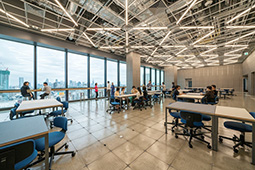INDEX
- English
- 日本語

SHIBUYA SCRAMBLE SQUARE SHIBUYA SKY rooftop observation space “SKY STAGE” and Shibuya scramble crossing - English
- 日本語

SHIBUYA SKY view from the rooftop (Fuji area)

SHIBUYA SKY rooftop observation space “SKY STAGE” overlooking fireworks in the city center 


From top, SHIBUYA SKY CLOUD HAMMOCK, SHIBUYA SKY CROSSING LIGHT, SHIBUYA QWS “PROJECT BASE”
July 2020
Entertainment City Shibuya

Shibuya, symbolized by its scramble crossing, features many popular shopping and entertainment spots and is often used as a setting for movies, TV shows and music videos. This lively area of Tokyo, which has long been a hub for youthful fashion, art and culture, is currently undergoing another transformation.

Throughout the year, Tokyo’s Shibuya is an area bustling with people. When busy, around 3,000 pedestrians cross Shibuya’s scramble crossing, right in front of Shibuya Station, during a single green light. The statue of an Akita dog called Hachiko, a popular spot to meet up with others near the crossing, is now known internationally through the movie, Hachi.
Development around the train station in Shibuya began at the beginning of the twentieth century. Despite a majority of the area being destroyed by fire in the Second World War, the National Stadium, one of the main venues for the 1964 Tokyo Olympics (see Highlighting JAPAN November 2017), was built here, as well as theaters, cinemas, department stores, and more. In the 1970s and 80s, commercial facilities for fashion were opened one by one, and shops to attract young people appeared, featuring unique fashion from up and coming designers, interior design, music, and more. This trend wasn’t limited to just the area around Shibuya Station, but has expanded to the Harajuku, Omotesando and Daikanyama areas, too, which are located one station away from Shibuya on various train lines. And so, young people looking for something new gather in Shibuya, and from them, new trends emerge. The area has developed as a hub for trends, bursting with energy where the culture, society, and economy move around young people.
Shibuya is now in the midst of a once-in-a-century large-scale redevelopment.
Hamamoto Rie from Tokyu Corporation’s Development Planning Group of Shibuya Development Headquarters, states, “Our future vision for Shibuya at the Tokyu Group is ‘Entertainment City Shibuya’. Utilizing the characteristics of Shibuya, an area which has continued to create new trends, we are moving forward with our efforts to make it a place full of a variety of content where anyone can enjoy themselves.”
Shibuya Station features nine train lines from four companies, and sees around 3.3 million passengers on average each day. As the station has been extended and renovated multiple times, the flow of pedestrians within the station is complicated and it is difficult to navigate, and this has been identified as a problem. The area has also dealt with the problems of aging station facilities built around the 1964 Tokyo Olympics and a shortage of space for hotels and offices.

To solve these problems, multifaceted studies on convenience, the environment, disaster prevention, and more have been carried out since the beginning of this century for large-scale redevelopment centered around Shibuya Station. Local residents also participated in these studies, in addition to the Shibuya City local government and other governmental organizations, related businesses, and experts and scientists in fields such as architecture and urban planning.
Tokyu Group’s “Entertainment City Shibuya” is one of the visions born out of these studies. Through the nine redevelopment projects around the station, this vision aims to gather a variety of entertainment facilities, including domestic and foreign companies, event halls, theaters, and more, centered around the creative content industry. It also aims to create a way to continue to showcase Shibuya’s unique culture to the world and to generate a new flow of people into Shibuya and the surrounding areas. Starting with Shibuya Hikarie, which opened in 2012, six projects have so far been completed, and commercial facilities, hotels, event halls, offices, and other facilities have been further enhanced. Pedestrian decks connecting the station with buildings as well as elevators and escalators connecting underground areas to above ground areas have been newly built, making the flow of traffic simpler and smoother.
“The station area redevelopment is expected to be completed by 2027,” says Hamamoto. “But thereafter, the development of Shibuya will surely continue, as it is a central area adjacent to such charming areas as Harajuku, Omotesando and Daikanyama.”
The bold redevelopment of the Shibuya area feels like a living organism that is continuing to evolve. Have a look for yourself from SHIBUYA SKY, the approximately 230-meter-high rooftop observation deck at the top of Shibuya Scramble Square, completed in 2019.




